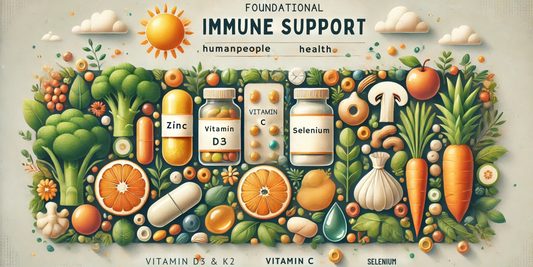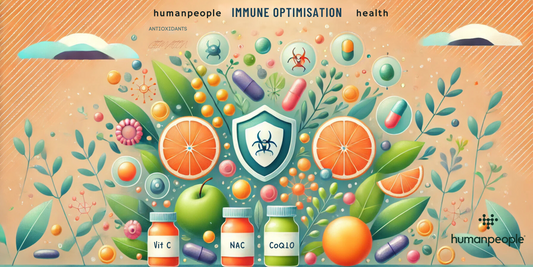Hallmarks of ageing: 1/12- Genomic Instability
In our "Longevity Insights" series, we're diving deep into the science of ageing, uncovering the vital biological processes that mark the passage of time in our bodies. Each aspect we explore is not just a piece of the ageing puzzle but a fundamental biological process that evolves with age, impacting our tissue and organ function.
Our goal? To demystify these complex processes and provide practical biohacks, empowering you to take charge of your health and well-being. By understanding and intervening in these ageing mechanisms, we can potentially reclaim and maintain our bodily functions, which, once lost, can be challenging to restore.
In this series, we're not just skimming the surface. We're delving into the depths of the science behind aging and offering tangible, daily strategies to positively impact these processes.
So, to begin, what actually qualifies a "process" to become one of the hallmarks of ageing. Well there are 4 basic criteria:
- Fundamental Process: It must represent a fundamental biological process that progressively changes with age.
- Contribution to Ageing: It should contribute to the ageing process and have a detrimental effect on tissue and organ function.
- Prevalence in Different Species: Ideally, it should be observable across multiple species, indicating its evolutionary and biological significance.
- Intervention Impact: There should be evidence that manipulating this process can affect the rate of ageing and increase lifespan or healthspan.
In simple terms, to be considered a hallmark of ageing, a mechanism must be a core biological process that worsens with age, contributes to the overall decline in bodily functions, be generally observed in different species, and show that changing it can alter the ageing process.
Introduction: The Cookbook of Life: Understanding the Science Behind Longevity

Have you ever wondered about the intricate science behind living a longer, healthier life? Recently, during a thought-provoking discussion with a patient, we delved into various longevity techniques. It dawned on me how many people enthusiastically adopt these methods with only a surface-level understanding of their underlying mechanisms. Inspired by this, I’ve decided to take on the challenge to unfold the complexities of the 12 causes of ageing in a manner that will not only help you to understand what we believe is going on but also throw in a few biohacks along the way.
The aim of this is to motivate you to take ownership of the one body you have. This will help you understand how vitally important it is to prevent a loss of function because once you lose function, it’s tough getting it back.
This series aims not just to scratch the surface but to dive deeper into the science behind these processes. Additionally, I'll share actionable tips that you can incorporate into your daily routine to impact these ageing mechanisms positively.
Protecting the Cookbook of Life - Battling Genomic Instability
Imagine your DNA as a personal cookbook for life, an extraordinary archive dictating the creation of new cells, proteins, and hormones, ensuring your body functions seamlessly. However, just like my favourite cookbook (FISH by J Sheekey, with its amazing fish pie recipe), your DNA is subject to wear and tear over time, a phenomenon known as 'Genomic Instability.' This is akin to minor typos creeping into your vital recipe book, leading to suboptimal outcomes as you age.
As our cells divide and replicate, our DNA does too. Despite the high fidelity of each replication, errors, or 'eros,' can occur. These errors are tiny yet significant. We can see these errors creeping in before your eyes like a vibrant tapestry of life's journey on your skin.
I’m talking about age spots, those natural bookmarks of time, which are in part a manifestation of 'Genomic Instability.' It’s akin to the tiny misprints in your skin cells' DNA altering the story of your skin.
Why Is That Bad?
If your go-to cookbook started confusing teaspoons with tablespoons or grams with kilograms, you'd undoubtedly end up with some culinary disasters. Similarly, these DNA 'typos' can cause cells to behave erratically. Take age spots as an example: it's as if the recipe calls for a modest six brownies, but due to a DNA mix-up, your body decides to bake sixty! In skin terms, this means an overproduction of melanin and an age spot appears.
Here’s What to Do:

Lifestyle Hack: Antioxidant-Rich Foods
Think of antioxidants in foods (like berries, nuts, and greens) as a protective cover for your DNA cookbook. They arm your body with the necessary tools to combat inflammation and free radical damage. My tip: aim for five colours on your plate to get a diverse range of antioxidants. If it’s all beige on there, you might be getting the calories and even proteins, but you’re depriving your body of some necessary nutrients.
Age Spots: More Than Just Skin Deep
Our skin is a living history book, recording our life experiences. Age spots, those distinct marks that appear over time, are a visible indicator of genomic instability. These spots occur when DNA errors in skin cells lead to an overproduction of melanin, the pigment responsible for skin colour. This overproduction is often triggered by external factors like sun exposure, which accelerates DNA damage and the ageing process.
Protecting your skin from the sun is like safeguarding a precious page of your cookbook. I used to say the higher, the better, but now I suggest choosing SPF 30 over SPF 50. The difference in protection is a mere 0.8%, but with significantly fewer chemicals, it tends to sit better on the skin.
Biohack: Exercise and NAD Level Boosting

Regular exercise acts like dispatching a DNA repair team. It activates sirtuins, critical proteins for DNA repair and cellular health. Moreover, maintaining optimal NAD (Nicotinamide Adenine Dinucleotide) levels is vital for supporting these repair mechanisms, ensuring that your cellular machinery operates efficiently.
Ways to boost NAD levels:
1. NMN The precursor to NAD has been shown to increase NAD levels when taken orally.
2. Trans-resveratrol stimulates the production of NAD in the cells.
3. Quercetin slows down the breakdown of NAD.
4. NAD booster pack combines all three in a single pack.
Lifestyle and Biohacks: Protecting Your Genetic BlueprintIncorporating antioxidant-rich foods into your diet is a straightforward strategy for safeguarding your DNA. These antioxidants neutralise harmful free radicals and unstable molecules that can damage cells and contribute to ageing and diseases. Sun protection is another crucial step. Choosing the proper SPF minimises DNA damage caused by UV radiation.
Intermittent fasting and spermidine supplementation can boost cellular autophagy, a process where cells remove damaged components, including faulty DNA. This helps maintain cellular integrity and function. Exercise plays a dual role; it not only enhances physical fitness but also stimulates the production of sirtuins, proteins that play a key role in DNA repair and cell survival.
Investing in Your Future Self: The Long-Term ViewEmbracing these lifestyle and biohacking strategies does more than just maintain your current health; it's an investment in your future well-being. Protecting and repairing your DNA is vital to prevent diseases like cancer, as healthy DNA is the cornerstone of good health.
The Intricacies of DNA Repair and Cellular Health- The Science

DNA repair is a complex process involving various pathways. One key mechanism is base excision repair, which fixes small, non-helix-distorting base lesions caused by oxidation and alkylation damage. Another is nucleotide excision repair, which corrects helix-distorting DNA damage caused by UV light.
Sirtuins, particularly SIRT1, play a critical role in maintaining genomic stability. They're involved in DNA repair, regulation of cell cycle, and apoptosis. SIRT1 also influences the activity of PARP-1, a protein essential for repairing DNA single-strand breaks.
NAD+, a coenzyme in all living cells, is crucial for various metabolic processes. It's particularly important for the functioning of sirtuins and PARP-1. Levels of NAD+ naturally decline with age, which impairs these critical cellular processes.
Autophagy, stimulated by practices like intermittent fasting, is the body's way of cleaning out damaged cells to regenerate newer, healthier cells. This process is crucial for cellular rejuvenation and preventing the accumulation of cellular debris, which can contribute to ageing and disease.
Conclusion
Embracing the Journey of Ageing with Science and Self-CareUnderstanding and applying these principles is a powerful way to influence your ageing process positively. By taking proactive steps today, you're not only improving the quality and enjoyment of life today, but you are also safeguarding your health for the future.
Ways to boost NAD levels:
1. NMN The precursor to NAD has been shown to increase NAD levels when taken orally.
2. Trans-resveratrol stimulates the production of NAD in the cells.
3. Quercetin slows down the breakdown of NAD.
4. NAD booster pack combines all three in a single pack.
References
- López-Otín, C., et al. "The Hallmarks of Aging." Cell, vol. 153, no. 6, 2013, pp. 1194-1217.
- López-Otín C, Blasco MA, Partridge L, Serrano M, Kroemer G. Hallmarks of aging: An expanding universe. Cell. 2023;186(2):243-278.
- Blackburn, E. H., et al. "Telomeres and Telomerase: Their Mechanisms of Action and the Effects of Altering Their Functions." FEBS Letters, vol. 579, no. 4, 2005, pp. 859-862.
- Imai, S., et al. "NAD and Sirtuins in Aging and Disease." Trends in Cell Biology, vol. 24, no. 8, 2014, pp. 464-471.
- Jon D. Lane, Bernadette Carroll, Graeme Hewitt, Viktor I. Korolchuk; Autophagy and ageing: implications for age-related neurodegenerative diseases. Essays Biochem 27 September 2013; 55 119–131.
- Koltai E, Szabo Z, Atalay M, Boldogh I, Naito H, Goto S, Nyakas C, Radak Z. Exercise alters SIRT1, SIRT6, NAD and NAMPT levels in skeletal muscle of aged rats. Mech Ageing Dev. 2010 Jan;131(1):21-8.
- T. Izumi, I. Mellon., et al. "Base Excision Repair and Nucleotide Excision Repair." Genome Stability, Academic Press, 2016, Pages 275-302,
- Chatterjee N, Walker GC. Mechanisms of DNA damage, repair, and mutagenesis. Environ Mol Mutagen. 2017 Jun;58(5):235-263. doi: 10.1002/em.22087. Epub 2017 May 9.
- Choi W, Yin L, Smuda C, Batzer J, Hearing VJ, Kolbe L. Molecular and histological characterization of age spots. Exp Dermatol. 2017 Mar;26(3):242-248.
- Alves-Fernandes DK, Jasiulionis MG. The Role of SIRT1 on DNA Damage Response and Epigenetic Alterations in Cancer. Int J Mol Sci. 2019 Jun 28;20(13):3153.
- Covarrubias AJ, Perrone R, Grozio A, Verdin E. NAD+ metabolism and its roles in cellular processes during ageing. Nat Rev Mol Cell Biol. 2021 Feb;22(2):119-141.






